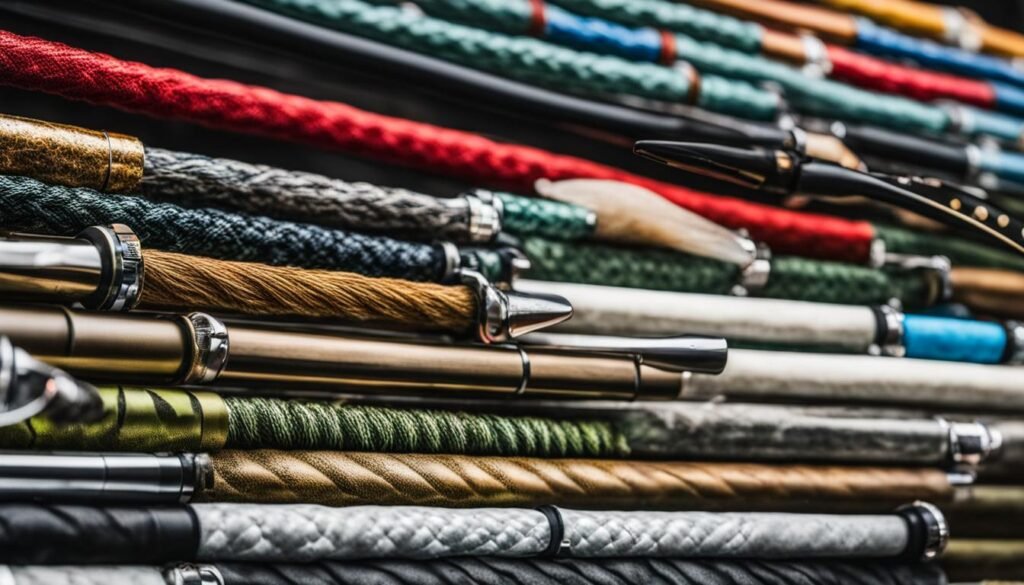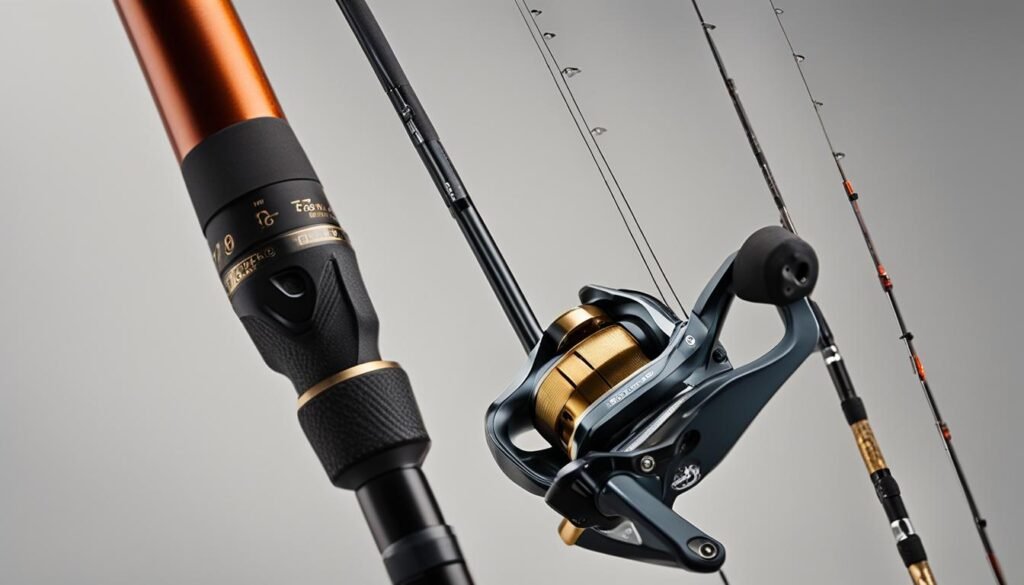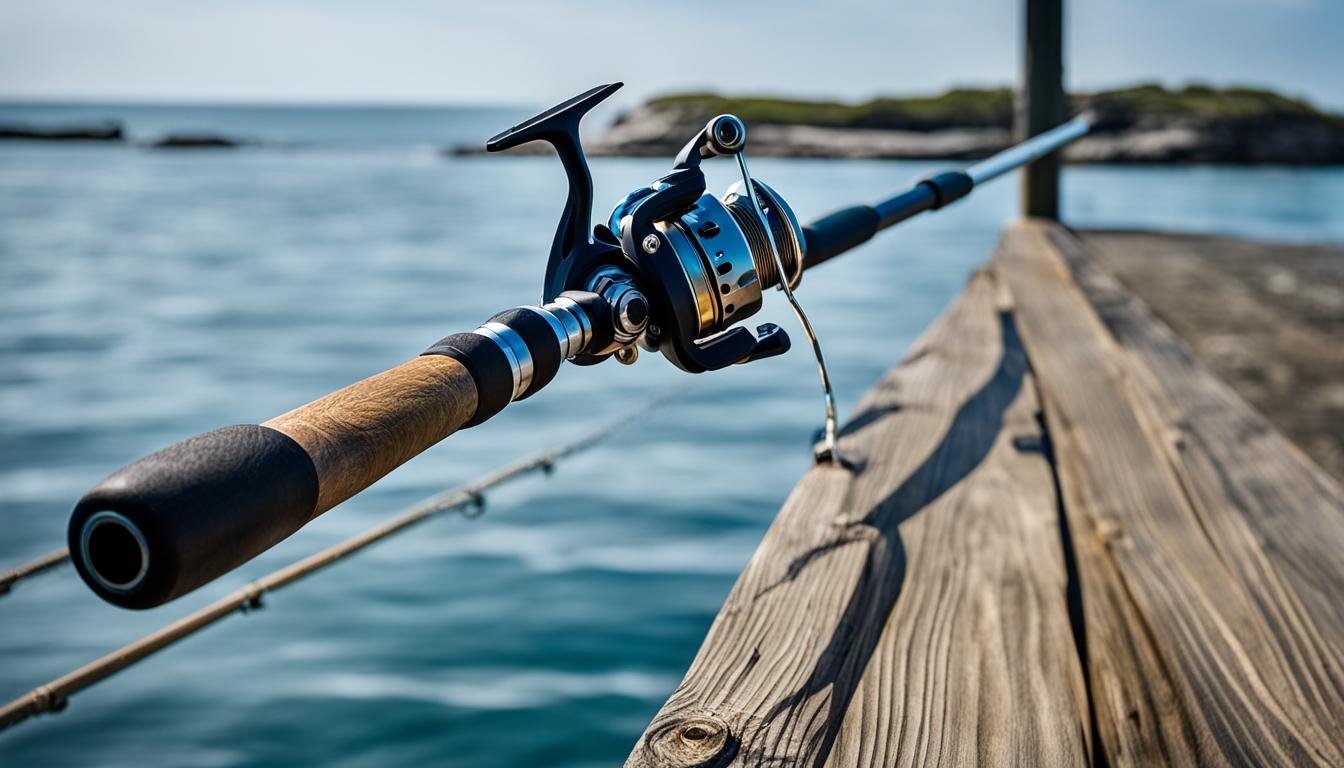When it comes to sea fishing, having the right rod can make all the difference in your angling success. With so many options available, it can be overwhelming to choose the perfect sea fishing rod. But fear not, I’m here to help you navigate through the sea of choices and find the rod that best suits your needs and preferences.
Key Takeaways:
- Consider the length of the fishing rod, as it affects casting distance and maneuverability.
- Choose the right material for your sea fishing rod, whether it be fiberglass, graphite, or a composite.
- Understand the importance of rod action and power, as they determine how the rod performs under pressure.
- Decode the rod markings and pay attention to other components like rod guides and handles.
- Take into account various factors, such as power, action, length, material, line guides, and reel seats when making your selection.
Choosing the Right Fishing Rod Length
When it comes to selecting a sea fishing rod, one of the most important considerations is its length. The length of a fishing rod directly affects both casting distance and maneuverability, making it a crucial factor to determine the right rod for your needs.
Shorter fishing rods, typically ranging from 5 to 7 feet, provide more control and power. These rods are ideal for close-quarter fishing or when targeting larger fish that require more strength to reel in. With a shorter rod, you have better leverage and can exert greater force on the fish, increasing your chances of a successful catch.
On the other hand, longer fishing rods, ranging from 7 to 12 feet, offer the advantage of longer casts. They are particularly suitable for fishing from a distance or in open water where you need to cover more ground. Longer rods provide better reach and allow you to cast your line further, giving you a wider range to explore and increasing your chances of finding fish. However, longer rods may sacrifice some control and power, so consider your fishing style and the specific type of fishing you’ll be doing when choosing the length of your sea fishing rod.
Remember, the length of the fishing rod is a personal preference and should be based on your fishing goals and the type of fish you plan to target. By understanding the advantages and disadvantages of different rod lengths, you can make an informed decision and select a sea fishing rod that suits your angling needs.
| Length | Advantages | Disadvantages |
|---|---|---|
| Short (5-7 feet) | Improved control and power | Less casting distance |
| Medium (7-9 feet) | A balance of control and casting distance | Slightly reduced power compared to shorter rods |
| Long (9-12 feet) | Increased casting distance | Less control and power |
Table: Comparison of Fishing Rod Lengths
Understanding Different Rod Materials

When it comes to selecting the right fishing rod for your sea fishing adventures, one important factor to consider is the material from which the rod is made. There are three common materials used in fishing rod construction: fiberglass, graphite, and composite. Each material has its own unique characteristics, and understanding them will help you choose the best sea fishing rod for your needs.
The benefits of fiberglass fishing rods
Fiberglass fishing rods are known for their durability and affordability. They can withstand rough handling and are less likely to break compared to other materials. Fiberglass rods are also great for beginners due to their forgiving nature and resistance to damage. However, they may lack sensitivity, making it harder to detect subtle bites or changes in the underwater environment.
The advantages of graphite fishing rods
Graphite fishing rods are popular among professionals and experienced anglers due to their lightweight and sensitive nature. These rods provide excellent feedback, allowing you to feel even the slightest movement at the end of your line. Graphite rods are also known for their versatility, making them suitable for a wide range of fishing techniques. However, they can be more brittle and expensive compared to fiberglass rods, so they require more delicate handling.
The versatility of composite fishing rods
Composite fishing rods combine the best qualities of fiberglass and graphite. They offer a balance of strength, sensitivity, and flexibility, making them a great choice for anglers who want the best of both worlds. Composite rods are often more expensive than fiberglass rods but offer improved performance and durability. They are suitable for various fishing styles and can handle different types of fish. If you’re looking for a versatile sea fishing rod that provides a good balance between strength and sensitivity, a composite rod may be the ideal choice.
When selecting a sea fishing rod, consider your fishing needs, preferences, and budget. Fiberglass rods are great for beginners and those on a tight budget, while graphite rods are favored by experienced anglers who prioritize sensitivity. Composite rods offer a middle ground and are suitable for a wide range of fishing situations. By understanding the different rod materials and their characteristics, you can make an informed decision and choose a sea fishing rod that meets your specific requirements.
Exploring Rod Action and Power
When selecting a sea fishing rod, understanding the rod’s action and power is crucial. Rod action refers to how much the rod bends when pressure is applied, while rod power determines its lifting capacity. Different rod actions and powers are suited for various fishing scenarios and target species. Let’s take a closer look at the three main rod actions and the range of rod powers available.
Fast Action Rods
Fast action rods have a stiff tip and bend mostly in the top third or quarter of the rod. They offer excellent sensitivity and responsiveness, making them ideal for quick and powerful hook sets. Fast action rods are particularly useful when targeting larger, more aggressive fish. Their stiff nature allows anglers to exert more pressure when fighting fish, increasing the chances of landing them successfully.
Medium Action Rods
Medium action rods bend throughout the top half of the rod, offering a versatile blend of power and flexibility. These rods provide a forgiving bend that absorbs the force of a fish’s movements, reducing the risk of hook pulls. Anglers often choose medium action rods for a wide range of fishing techniques and species. Whether you’re casting lures or fishing with bait, a medium action rod can handle the job.
Slow Action Rods
Slow action rods bend throughout their entire length, offering a more parabolic curve. They are incredibly flexible, allowing anglers to cast further and present baits with precision. Slow action rods are popular among fly fishermen who need delicate presentations. Additionally, they provide an enjoyable fight with smaller fish, as the rod’s flexibility enhances the angler’s connection to the fish.
Now let’s turn our attention to rod power. Rod power refers to the strength of the rod and its ability to handle different fish sizes and line weights. The power rating typically ranges from ultra-light to heavy, with variations in between.
| Rod Power | Characteristics |
|---|---|
| Ultra-Light | Designed for small fish species and light lines |
| Light | Suitable for a variety of fishing techniques and smaller fish |
| Medium-Light | A balance between sensitivity and power for versatile fishing |
| Medium-Heavy | Ideal for targeting larger fish species and handling heavier lines |
| Heavy | Designed for heavy-duty fishing, such as deep-sea or big game fishing |
Choosing the right rod action and power boils down to your fishing style, target species, and personal preference. It’s essential to consider factors such as the type of fishing you’ll be doing, the size of fish you’re targeting, and the strength of the line you’ll be using. By understanding these factors, you’ll be able to select a sea fishing rod that optimizes your angling experience.
Decoding Rod Markings and Other Components
When selecting a fishing rod, it’s essential to understand the markings and other components that can provide valuable information about the rod’s specifications and performance. These markings are typically found on the rod itself and can help you determine the length, action, recommended line and lure weights, and other important details. Let’s explore the significance of rod markings and the role of other components in choosing the perfect fishing rod.
Understanding Rod Markings
Rod markings serve as a guide to help anglers quickly identify important features of a fishing rod. These markings may include numbers, letters, or symbols that represent specific characteristics. For example, a marking like “6’6″ MH” indicates that the rod is 6 feet 6 inches long and has a medium-heavy power rating. Additionally, markings such as “15-30 lb” suggest the recommended line weight range for optimal performance. By deciphering these markings, you can easily determine if a rod meets your requirements.
Exploring Rod Guides and Handles
Rod guides are an integral part of a fishing rod and play a crucial role in line management and sensitivity. These small circular rings are attached along the length of the rod and guide the fishing line during casting and retrieval. High-quality rod guides are made of materials like ceramic or titanium to reduce friction and prevent line wear. Additionally, the handle of a fishing rod is another important component that affects comfort and grip. Handles are typically made of materials like cork or EVA foam, providing a comfortable and secure hold during long fishing sessions.
Other Fishing Rod Components
In addition to rod markings, guides, and handles, fishing rods may feature other components that contribute to their overall performance and functionality. Some rods may have a reel seat, which is the part of the rod that holds the reel securely in place. Reel seats come in different styles and materials, ensuring a proper fit for various reel types. Furthermore, advanced fishing rods may incorporate innovative features like adjustable handles or detachable sections, offering anglers greater versatility and customization options.
Understanding rod markings and other components is essential for selecting the right fishing rod that suits your preferences and fishing style. By decoding rod markings and considering the quality and functionality of rod guides, handles, and other components, you can make an informed decision and find a fishing rod that enhances your angling experience.

Factors to Consider When Choosing a Fishing Rod
When it comes to selecting a fishing rod, several factors come into play to ensure the right fit for your angling needs. To make an informed decision, consider the following key factors:
- Fishing Rod Power: This refers to the rod’s ability to handle pressure and indicates the amount of force needed to make the rod bend. Power options typically range from ultra-light to heavy, with each having its own recommended line and lure weights. Choosing the right power ensures you have the right balance between strength and sensitivity for the fish you’re targeting.
- Fishing Rod Action: Action determines how much the rod bends when pressure is applied. It affects the rod’s sensitivity and hook-setting ability. Action options include fast, medium, and slow. A fast action rod has a stiff tip, allowing for quick hook setting and handling larger fish. A medium action rod provides versatility for various fishing situations, while a slow action rod bends throughout its length, allowing for long casts and accurate presentations.
- Fishing Rod Length: The length of the rod plays a crucial role in casting distance, control, and maneuverability. Shorter rods offer more control and power, making them suitable for close-quarter fishing or targeting larger fish. Longer rods allow for longer casts and are ideal for fishing from a distance or in open water. Consider your fishing style and the specific type of fishing you’ll be doing to choose the appropriate length.
Other factors to consider include the material of the rod, the design of the rod guides, and the type of reel seat. The material choice impacts the rod’s weight, sensitivity, and durability. Common options include fiberglass, graphite, or composite materials. Rod guides play a role in line management and sensitivity, while the reel seat affects the overall performance and comfort of the rod.
By taking these factors into account, you can choose a fishing rod that suits your fishing style, target species, and personal preferences. Remember that each factor contributes to the overall performance and success of your fishing experience, so it’s important to carefully evaluate and select the right rod.
Table: Fishing Rod Factors
| Factor | Description |
|---|---|
| Fishing Rod Power | The rod’s ability to handle pressure and the recommended line and lure weights for optimal performance. |
| Fishing Rod Action | The amount of bend the rod has when pressure is applied, affecting sensitivity and hook-setting ability. |
| Fishing Rod Length | The overall length of the rod, impacting casting distance, control, and maneuverability. |
| Material | The type of material used to construct the rod, impacting weight, sensitivity, and durability. |
| Rod Guides | The design and placement of the guides, affecting line management and sensitivity. |
| Reel Seat | The type of seat that holds the reel, influencing overall performance and comfort. |
Conclusion
After carefully considering the various factors involved in selecting a sea fishing rod, it is clear that finding the perfect rod requires a thoughtful approach. By understanding the importance of rod length, material, action, power, and rod markings, you can make an informed decision that matches your fishing style and target species.
When choosing a sea fishing rod, it is essential to prioritize your specific needs and preferences. Whether you are a beginner or a seasoned angler, the right fishing rod is crucial for a successful and enjoyable fishing experience.
Remember, the process of selecting a fishing rod should not be rushed. Take the time to research different options, test them out, and seek advice from experts if necessary. By following these expert tips for fishing rod selection, you can increase your chances of finding the perfect sea fishing rod that meets all your requirements.
FAQ
What factors should I consider when choosing a sea fishing rod?
When choosing a sea fishing rod, you should consider factors such as power, action, length, material, line guides, and reel seats.
How does the length of a fishing rod affect its performance?
The length of a fishing rod affects casting distance and control. Shorter rods provide more control and power, while longer rods allow for longer casts and are ideal for fishing from a distance or in open water.
What are the different materials used for fishing rods?
Fishing rods are commonly made from fiberglass, graphite, or composite materials. Fiberglass rods are durable and affordable but may lack sensitivity. Graphite rods are lightweight and sensitive, providing better feedback. Composite rods offer flexibility, strength, and sensitivity.
What is rod action and how does it impact fishing?
Rod action refers to how much the rod bends when pressure is applied. Fast action rods have a stiff tip and are sensitive, making them ideal for powerful hook setting and large fish. Medium action rods have a more forgiving bend and are versatile for various fishing situations. Slow action rods bend throughout the length, allowing for further casting and more accurate presentations.
What do the markings on a fishing rod indicate?
Rod markings provide important information about the length, action, and recommended line and lure weights of the rod. Understanding these markings helps you determine the specifics of a rod quickly.
What other components of a fishing rod should I consider?
Other components such as rod guides and handles play a role in performance and comfort. Rod guides help with line management and sensitivity, while the handle should be comfortable and suit your preferences.
What factors should I consider when choosing a fishing rod?
When choosing a fishing rod, factors such as power, action, length, material, line guides, and reel seats should be considered. These factors determine the rod’s ability to handle pressure, how much it bends, its casting distance and control, its weight, sensitivity, and durability, and its overall performance and comfort.
How can I find the perfect sea fishing rod for my needs?
Understanding the factors discussed and how they impact performance and comfort will help you choose a rod that matches your fishing style and target species. Researching and testing different options will also help you find the perfect sea fishing rod for your needs.
Source Links
- https://www.floridasportfishing.com/archives/fishing-cat/ask-the-experts-selecting-the-ideal-inshore-saltwater-fishing-rod/article_f6b01bd7-a7a2-5f28-966e-cd75616b65df.html
- https://fishingbooker.com/blog/choosing-a-fishing-rod/
- https://blog.overtons.com/fishing/guide-choosing-the-perfect-fishing-rod

